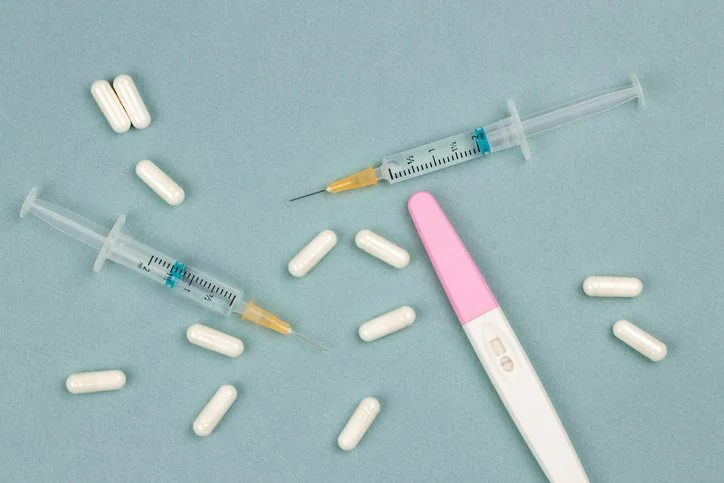IVF Meds Stress Your Eggs - Red Light Therapy Can Help Protect Them
As someone who works closely with women during their fertility challenges, I know just how critical it is to understand and address oxidative stress, especially during IVF and other assisted reproductive treatments. Here’s what every patient and clinician should know about stimulation drugs, free radicals, and practical ways to support egg quality through evidence-based science.
Oxidative Stress in Fertility: Let’s Clear Up the Confusion
Picture your ovaries during a fertility cycle as a busy workshop building beautiful, delicate eggs. In the process, tiny “sparks” (free radicals) fly around. A healthy body’s antioxidants - your natural sprinkler system, quickly neutralize these sparks before they can do harm. But when stimulation drugs boost ovarian activity, more sparks fly, and if there aren’t enough “sprinklers” to keep up, some of those sparks can ignite fires that damage egg DNA and machinery.
Stimulation Drugs and Oxidative Stress: What Does the Research Say?
Ovarian stimulation, fundamental to most IVF protocols, significantly increases metabolic activity in the ovaries. Multiple well-conducted studies confirm that drugs like FSH and LH lead to higher levels of reactive oxygen species (ROS) or “free radicals,” both in the blood and in the follicular fluid, a trend amplified in women with PCOS, endometriosis, or after repeated stim cycles.
· Key clinical findings:
o A 2023 study reported that women with a higher antioxidant capacity in their follicular fluid had a cumulative pregnancy rate of 70%, compared to just 38% in women with lower antioxidant protection. (A striking demonstration of how crucial the balance is for egg quality and overall IVF success!)
o Markers of oxidative stress, such as malondialdehyde (MDA) and advanced oxidation protein products (AOPP), rise after pituitary suppression and through the stimulation phase, while antioxidant defenses in the fluid around the egg become depleted.
o Gonadotropins used in IVF (especially FSH) directly stimulate the production of free radicals in the ovaries, and higher doses or repeated cycles further increase this effect.
o Excessive free radicals aren’t just a theoretical worry, they damage mitochondria, DNA, and reduce the chances of embryos making it to transfer and implantation.
Photobiomodulation (PBM): Can Red Light Therapy Really Help?
Photobiomodulation (PBM) is emerging as a supportive technology with promising results in animal and early human studies. At clinically optimized doses, PBM with red and near-infrared (NIR) light has been shown to:
· Reduce biochemical markers of oxidative stress (like MDA and lipid peroxides).
· Boost levels of key antioxidant enzymes (such as SOD and glutathione peroxidase).
· Improve cellular energy, blood flow, and tissue recovery.
Practical Strategies: How to Support Your Antioxidant Defenses
1. Eat for Antioxidant Power
Colorful fruits and vegetables (berries, citrus, leafy greens), nuts, seeds, and whole grains provide a natural arsenal of antioxidants to neutralize free radicals.
2. Consider Supplementation - If Advised
While supplements like CoQ10, vitamin D, and myo-inositol are commonly used, high-quality evidence for major IVF outcome improvement is mixed and varies between individuals. Always discuss with your care team before adding to your regimen.
3. Move Your Body - Gently
Moderate activity helps reduce inflammation and supports healthy ovarian function, while overtraining can actually add to oxidative stress.
4. Minimize Stress
Mindful breathing, meditation, and restorative practices can lower background inflammation and protect reproductive health. (Use any of my affiliate links for my recommended red light devices and you’ll receive complimentary access to my FertileMind app specifically for fertility related stress).
5. Avoid Toxins
It goes without saying…stop smoking, limit alcohol, and steer clear of environmental toxins (whenever possible) - these all contribute to more sparks in your reproductive workshop.
Find the most effective fertility red light device for home use.
Use my affiliate link and receive a detailed protocol based on your health history and current treatment timeline.
Research Spotlight - How IVF Meds Can Increase Cellular Stress
· Controlled Ovarian Stimulation: Both blood and follicular fluid measurements show that stimulation drugs drive up free radical levels and lower antioxidant capacity. Repeated or high-dose stimulation and underlying reproductive conditions worsen the imbalance (this is especially important for anyone considering doing back to back ART).
· Egg Quality and Success Rates: High oxidative stress seems to correlate with DNA damage, poor oocyte maturation, and lower chances of pregnancy or live birth.
· Antioxidant Balance Makes a Difference: More “sprinklers” (antioxidant protection) in the ovarian environment is consistently linked to improved IVF outcomes, real evidence that supports dietary, lifestyle, and targeted red light therapy interventions.
Women are caught between a rock and a hard place - you need the meds - but you also need to balance those levels of ‘sparks.’ But with scientific insights on diet, supplementation, stress reduction, and the appropriate use of PBM, there’s still a lot you can do. The right strategy is about more than just making more eggs, it’s about nurturing them in an optimal environment so every spark fuels life, not loss.
Tracy
Resources
· Zaha I. et al. (2023). The Role of Oxidative Stress in Infertility. J. Pers. Med., 13(8), 1264.
· The Impact of Controlled Ovarian Stimulation on Serum Oxidative Stress Markers, PMC (2022).
· Ovarian stimulated cycles reduce protection of follicular fluid against oxidative stress, Free Radical Biology & Medicine (2019)
· Follicle-stimulating hormone stimulates free radical generation..., Human Reproduction Open (2025).
· Oxidative stress: Oocyte quality and infertility. ScienceDirect (2025).
· Oxidative Stress in Assisted Reproductive Techniques, PMC (2023).
· Hamblin MR. (2017). Mechanisms and applications of the anti-inflammatory effects of photobiomodulation. AIMS Biophysics, 4(3), 337–361.
· Review of light parameters and photobiomodulation efficacy. Frontiers in Neuroscience (2018).
· Differences in Photobiomodulation & Red Light Therapy - Aspen Laser (2022).
· The Importance of Natural Antioxidants in Female Reproduction. PMC (2023).
· Dietary and Lifestyle Interventions to Mitigate Oxidative Stress in Fertility. Nutrients (2025)
⁂


